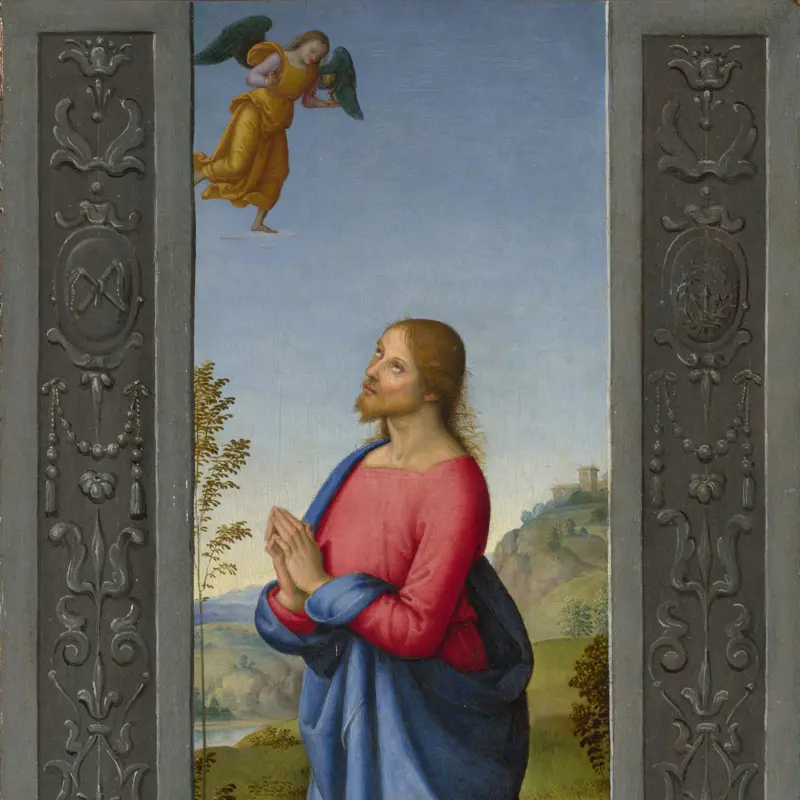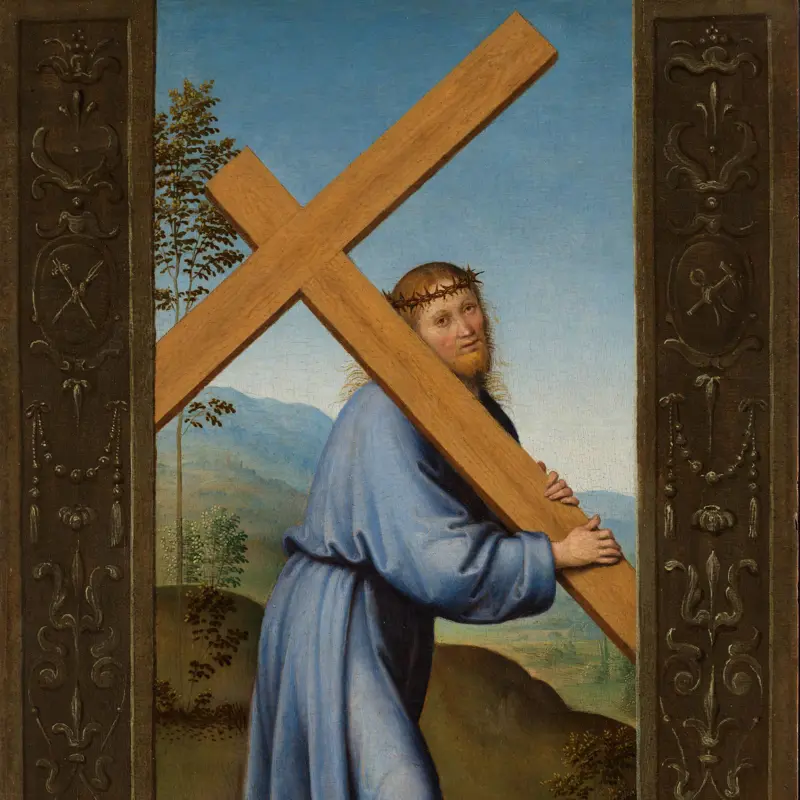Lo Spagna, 'Christ at Gethsemane', perhaps 1500-5
About the work
Overview
Christ kneels in prayer and looks up at an angel who holds a chalice. This is the beginning of the Passion (Christ’s torture and crucifixion), when Christ prayed in the garden at Gethsemane: knowing that he is to die, Christ asks God to ‘take this cup away from my lips’.
It was painted by Lo Spagna, an artist of Spanish origin who, after Raphael, was the most talented of Perugino’s associates. Lo Spagna – who spent most of his career in Southern Umbria - developed a sweet, charming yet idiosyncratic manner which distinguishes his paintings from the plethora of works produced in Perugino’s style.
Key facts
Details
- Full title
- Christ at Gethsemane
- Artist
- Lo Spagna
- Artist dates
- active 1504; died 1528
- Part of the series
- Scenes from the Passion of Christ
- Date made
- perhaps 1500-5
- Medium and support
- oil on wood
- Dimensions
- 34 × 26 cm
- Acquisition credit
- Bequeathed by Henry Vaughan, 1900
- Inventory number
- NG1812
- Location
- Room 61
- Collection
- Main Collection
- Frame
- 20th-century Replica Frame
Provenance
Additional information
'Text extracted from the ‘Provenance’ section of the catalogue entry in Martin Davies, ‘National Gallery Catalogues: The Earlier Italian Schools’, London 1986 and supplemented by Anna McGee; for further information, see the full catalogue entry.
Bibliography
-
1857G. Scharf, Catalogue of the Art Treasures of the United Kingdom: Collected at Manchester in 1857, Provisional Catalogue, Manchester 1857
-
1860J.D. Passavant, Raphaël d'Urbin et son père Giovanni Santi, Paris 1860
-
1865W. Bürger, Trésors d'art en Angleterre, Paris 1865
-
1951Davies, Martin, National Gallery Catalogues: The Earlier Italian Schools, London 1951
-
1957G. Andrés, El Marqués de Liche. Bibliófilo y coleccionista de arte, Madrid 1957
-
1961M. Davies, The Earlier Italian Schools, 2nd edn, London 1961
-
1963F. Haskell, Patrons and Painters - a Study in the Relations Between Italian Art and Society in the Age of the Baroque, London 1963
-
1968B. Berenson, Italian Pictures of the Renaissance: A List of the Principal Artists and Their Works, with an Index of Places: Central Italian and North Italian Schools, revised edn, 3 vols, London 1968
-
1984M.B. Burke, Private Collections of Italian Art in Seventeenth Century Spain, Ann Arbor 1984
-
1984F.G. Sabatini, Giovanni di Pietro, detto Lo Spagna, Spoleto 1984
-
1986Davies, Martin, National Gallery Catalogues: The Earlier Italian Schools, revised edn, London 1986
-
1989F. Todini, La pittura umbra: Al Duecento al primo Cinquecento, Milan 1989
-
1994C. Scailliérez, 'Une ébauche de Parmesan (1503-1540), pour le Louvre, un don de la Société des Amis du Louvre', Revue du Louvre, XLIII, 1994, pp. 27-37
-
1997P. Cherry and M.B. Burke, Collections of Paintings in Madrid, 1601-1755, vol. 1, ed. M.L. Gilbert, Los Angeles 1997
-
2001
C. Baker and T. Henry, The National Gallery: Complete Illustrated Catalogue, London 2001
-
2007A. Anselmi, 'Il VII Marchese del Carpio da Roma a Napoli', Paragone, LVIII/683, 2007, pp. 80-109
About this record
If you know more about this work or have spotted an error, please contact us. Please note that exhibition histories are listed from 2009 onwards. Bibliographies may not be complete; more comprehensive information is available in the National Gallery Library.
Images
About the series: Scenes from the Passion of Christ

Overview
These two small paintings probably once formed the wings of a portable altarpiece. They show different episodes from the Passion (Christ’s torture and crucifixion). In one, Christ kneels in prayer in the Garden of Gethsemane, just before he is arrested (Matthew 26: 39–42. In the other, he carries the cross on the way to be crucified, as described in all four Gospels.
The sweet, light style of these pictures links them to Pietro Perugino, who in the early sixteenth century was the most admired and commercial artist in central Italy. They were painted by Lo Spagna who, after Raphael, was the most talented of Perugino’s associates. A nineteenth-century source suggest they were made for Cardinal Giovanni de’ Medici, who became Pope Leo X.



